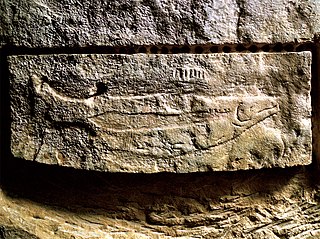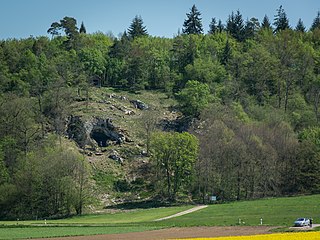
The Red "Lady" of Paviland is an Upper Paleolithic partial male skeleton dyed in red ochre and buried in Wales 33,000 BP. The bones were discovered in 1823 by William Buckland in an archaeological dig at Goat's Hole Cave which is a limestone cave between Port Eynon and Rhossili on the Gower Peninsula, near Swansea in south Wales. Buckland believed the skeleton was a Roman era female. Later, William Solace examined Goat's Cave Paviland in 1912. There, Solace found flint arrow heads and tools and correctly concluded that the skeleton was in fact a male hunter-gatherer or warrior during the last Ice Age. Over the last 100 years, more advanced dating procedures have shifted the age from the Mesolithic period to the Palaeolithic era of the last Ice Age.

Cro-Magnon is an Aurignacian site, located in a rock shelter at Les Eyzies, a hamlet in the commune of Les Eyzies-de-Tayac-Sireuil, Dordogne, southwestern France.

Édouard Lartet was a French geologist and paleontologist, and a pioneer of Paleolithic archaeology. He is also known for coining the prehistoric taxon Amphicyon, making it one of the earliest-described fossil carnivorans in the palaeontological record.

The Aurignacian is an archaeological industry of the Upper Paleolithic associated with Early European modern humans (EEMH) lasting from 43,000 to 26,000 years ago. The Upper Paleolithic developed in Europe some time after the Levant, where the Emiran period and the Ahmarian period form the first periods of the Upper Paleolithic, corresponding to the first stages of the expansion of Homo sapiens out of Africa. They then migrated to Europe and created the first European culture of modern humans, the Aurignacian.

The Magdalenian cultures are later cultures of the Upper Paleolithic and Mesolithic in western Europe. They date from around 17,000 to 12,000 years ago. It is named after the type site of La Madeleine, a rock shelter located in the Vézère valley, commune of Tursac, in France's Dordogne department.

Les Eyzies-de-Tayac-Sireuil is a former commune in the Dordogne department in Nouvelle-Aquitaine in southwestern France. On 1 January 2019, it was merged into the new commune Les Eyzies.

Aurignac is a commune in the Haute-Garonne department in southwestern France, close to the Pyrénées. It was the seat of the former canton of Aurignac, which was composed of 19 communes. It is part of the ancient region known as the Comminges.

Paleolithic Europe, or Old Stone Age Europe, encompasses the Paleolithic or Old Stone Age in Europe from the arrival of the first archaic humans, about 1.4 million years ago until the beginning of the Mesolithic around 10,000 years ago. This period thus covers over 99% of the total human presence on the European continent. The early arrival and disappearance of Homo erectus and Homo heidelbergensis, the appearance, complete evolution and eventual demise of Homo neanderthalensis and the immigration and successful settlement of Homo sapiens all have taken place during the European Paleolithic.

The Prehistoric Sites and Decorated Caves of the Vézère Valley is a UNESCO World Heritage Site in France since 1979. It specifically lists 15 prehistoric sites in the Vézère valley in the Dordogne department, mostly in and around Les Eyzies-de-Tayac-Sireuil, which has been called the "Capital of Prehistory". This valley is exceptionally rich in prehistoric sites, with more than 150 known sites including 25 decorated caves, and has played an essential role in the study of the Paleolithic era and its art. Three of the sites are the namesakes for prehistoric periods; the Micoquien, Mousterian, and Magdalenian. Furthermore, the Cro-Magnon rock shelter gave its name to the Cro-Magnon, the generic name for the European early modern humans. Many of the sites were discovered or first recognised as significant and scientifically explored by the archaeologists Henri Breuil and Denis Peyrony in the early twentieth century, while Lascaux, which has the most exceptional rock art of these, was discovered in 1940.

Laugerie-Basse is an important Upper Paleolithic archaeological site within the territory of the French commune Les Eyzies-de-Tayac-Sireuil in Dordogne. It is known for several works of art from the Magdalenian. In 1979, Laugerie-Basse, along with other nearby paleolithic sites, was inscribed on the UNESCO World Heritage List as Prehistoric Sites and Decorated Caves of the Vézère Valley.

Damjili – is a half-circular shaped cave site in Azerbaijan, where evidence of prehistoric human presence during the Paleolithic and Mesolithic was discovered.

The Taghlar cave is an archaeological site that was inhabited by prehistoric humans of the Mousterian culture during the Paleolithic. The cave is located in Azerbaijan, in the disputed region of Nagorno-Karabakh, in the southern part of Boyuk Taghlar village, on the left banks of the Guruchay River.

The Mladečské Caves are a cave complex in the municipality of Mladeč in the Czech Republic. It is located in the Třesín National Nature Monument within the Litovelské Pomoraví Protected Landscape Area.

The Pair-non-Pair Cave is located near the village of Prignac-et-Marcamps, Aquitaine:Gironde (33) department in France. Only discovered in 1881 it is known for remarkable prehistoric parietal engravings - petroglyphic representations of wild animals, "which rank among the most ancient examples of art made by prehistoric" humans, dating back to between 30.000 and 25.000 BP, the Aurignacian cultural period of the Upper Paleolithic.

The Goyet Caves are a series of connected caves located in Wallonia in a limestone cliff about 15 m (50 ft) above the river Samson near the village of Mozet in the Gesves municipality of the Namur province, Belgium. The site is a significant locality of regional Neanderthal and European early modern human occupation, as thousands of fossils and artifacts were discovered that are all attributed to a long and contiguous stratigraphic sequence from 120,000 years ago, the Middle Paleolithic to less than 5,000 years ago, the late Neolithic. A robust sequence of sediments was identified during extensive excavations by geologist Edouard Dupont, who undertook the first probings as early as 1867. The site was added to the Belgian National Heritage register in 1976.

The small Sirgenstein Cave, German: Sirgensteinhöhle is situated 565 m (1,854 ft) above sea level inside the 20 m (66 ft) high Sirgenstein, a limestone rock. The cave sits 35 m (115 ft) above the Ach River valley bottom in the central Swabian Jura, southern Germany. Archaeologist R. R. Schmidt excavated the site in 1906 during which he identified indices of prehistoric human presence. He recorded the complete stratigraphic sequence of Palaeolithic and Neolithic origin. In his 1910 analysis Schmidt inspired future archaeologists with his pioneering concept of including the excavation site within its geographic region, contextualizing it within a wide scientific spectrum and demonstrated valuable results as he correlated the Sirgenstein layer structure to those of prehistoric sites in France. Mammoth ivory beads dating from 39,000 to 35,000 years ago have been uncovered at the cave. Because of its historical and cultural significance and its testimony to the development of Paleolithic art, the cave was inscribed on the UNESCO World Heritage List as part of the Caves and Ice Age Art in the Swabian Jura site in 2017.

Pešturina is a cave in the municipality of Niška Banja in southeast Serbia. It is located southwest of Jelašnica and 20 km (12 mi) southeast of Niš. Artifacts from the Middle and Upper Paleolithic periods were discovered since the archaeological excavations began in 2006. The remains, identified as the Mousterian culture, were dated from 111,000 BP+ 5,000 to 39,000 BP + 3,000, which makes Pešturina one of the latest surviving Neanderthal habitats. The cave has been nicknamed the "Serbian Atapuerca".

The Levantine Aurignacian is an Upper Paleolithic culture of the Near-Eastern Levant that evolved from the Emiran culture. It was named so because of the similarity of stone tools with the Aurignacian culture in Europe. The Levantine Aurignacian used to be called Lower and Upper Antelian in old sources, from the site of Wadi Antelias in Lebanon. The most important innovation in this period is the incorporation of some typical elements of Aurignacian, like some types of burins and narrow blade points that resemble the European type of Font-Yves.

The Bockstein Cave, German: Bocksteinhöhle is part of the Bockstein complex – a White Jurassic limestone rock massif. The 15 by 20 m rock shelter, among small peripheral caves is situated around 12 m (39 ft) above the Lone River valley bottom, north of the towns of Rammingen and Öllingen, Heidenheim district in the central Swabian Jura, southern Germany. Several small openings, that are the actual entrances to the site, lead to various cave sections. The large frontal opening is of modern origin, created during the first excavation works in the late 19th century.

Fumane Cave is a dolomite cave in the Fumane Valley, which was formed in the Neogene period. The cave contains rich evidence of three prehistoric hominid cultures: Mousterian, Uluzzian and Aurignacian. Additionally, the cave has some of the oldest cave art that has been discovered in Europe.
























